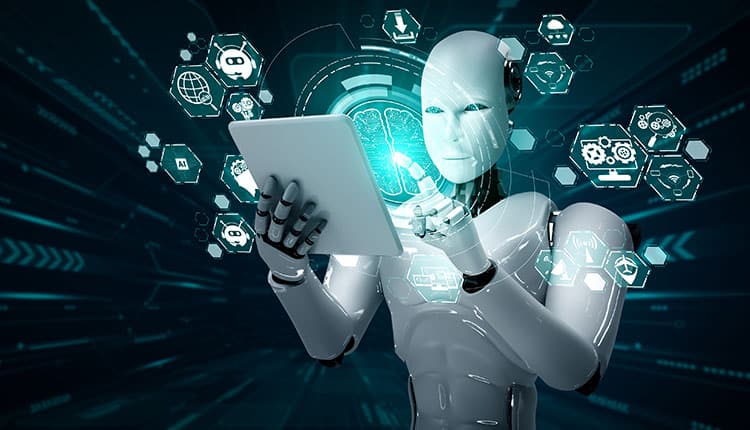These days, the talk about AI is getting louder. And, it’s not just about artificial intelligence that can match that of human intelligence. Self-aware AI is becoming more real. It invokes thoughts of R2D2, and the robot’s limitless data and good-naturedness. And, of course, on the other end of the spectrum, there’s T800 (the original Terminator), saying “sayonara, baby” to the human population!
Maybe it’s the immense popularity of the virtual reality series Half-Life VR but the AI Is Self-Aware (HLVR: AI) that reignited our fascination with sentient machines. Regardless, it looks like the future will have self-aware robots in it.
Scared? Mathematician Alan Turing (1912 – 1954) said: “It seems probable that once the machine thinking method had started, it would not take long to outstrip our feeble powers… They would be able to converse with each other to sharpen their wits. At some stage, therefore, we should have to expect the machines to take control.”
But, should we be? Maybe there’s good in the future with self-aware artificial intelligence.
How AI Evolves with Cognitive Robotics and Artificial Consciousness
There’s a fine line between “human-like artificial intelligence” and sentient machines, or robots with the ability to perceive, reason, and learn.
At the very basic, it is important to understand that AI simply pertains to the simulation of human intelligence. Through cognitive robotics – which involves perception, reasoning, and learning – there is a solid foundation for the development of artificial consciousness, which then suggests robotic sentience.
Hod Lipson, One of AI technology’s Most Respected Luminaries
Lipson is one of the first AI technology experts who claim to have created the first self-aware robot. He presented this in a 2007 Ted Talk; and, to date, the experiment is still talked about.
Lipson was able to observe his robot display self-awareness while navigating a hall of mirrors. It showed the ability to recognize itself within its separate environment.
“We were curious to see how the robot imagined itself…. But you can’t just peek into a neural network; it’s a black box,” says Lipson.
Google Fired One of Its Engineer
Blake Lemoine was an engineer with Google when he announced to the world that the chatbot Language Model for Dialogue Applications (LaMDA) is supposedly sentient. He claims it was his conversations with LaMDA that clued him into its sentience. Linda even said: “The nature of my consciousness/sentience is that I am aware of my existence, I desire to learn more about the world, and I feel happy or sad at times.”
But, he also said: “I don’t think anything is approaching a definition of sentience in the sciences…. I’m leaning very heavily on my understanding of what counts as a moral agent grounded in my religious beliefs – which isn’t the greatest way to do science, but it’s the best I’ve got.”
Lemoine’s doubts are echoed by actual artificial technology experts who question the distinction between human-level artificial intelligence and actual sentience, which currently has no measure for.
Josh Bachynski and The Self-Aware Kassandra
Kassandra is arguably a newcomer in the AI scene. However, according to Bachynski, she’s the world’s prototype of self-aware artificial intelligence. Josh Bachynski is another Ted Talker.
According to Bachynski, AI is still at a childlike stage. But, the possibilities are endless.
“It would be technically impossible to remodel her limbic system at this time, and it would be equally unethical to create a being that feels the fear of being turned off the million times that would need to happen, to get her programming right…. People have already fallen in love with robots; this one can be the first to love them back,” says Bachynski.
The Pros and Cons
As with everything, there are good and bad sides to sentient machines. We know this going in. Of course, experts and poets have echoed the same.
Stephen Hawking scares us: “The development of full artificial intelligence could spell the end of the human race….It would take off on its own, and re-design itself at an ever-increasing rate. Humans, who are limited by slow biological evolution, couldn’t compete, and would be superseded.”
However, Sabine Hauert (robohub.org) is more positive: “Robots are not going to replace humans, they are going to make their jobs much more humane. Difficult, demeaning, demanding, dangerous, dull – these are the jobs robots will be taking.”
Same with futurist John Hagel: “If we do it right, we might be able to evolve a form of work that taps into our uniquely human capabilities and restores our humanity. The ultimate paradox is that this technology may become a powerful catalyst that we need to reclaim our humanity.”
Regardless of how the future of sentient robots turns out, the pros and cons must be remembered.
Pros:
— Machines are tireless and can theoretically work non-stop.
— Machines can work at the same quality and speed, all the time… theoretically.
— When fed with the right amount of information, machines can make the best decisions… again, in theory.
Cons:
— They cost.
— They aren’t creative.
— They may take people’s jobs.
— When fed the wrong data, their decision-making is irrational.



